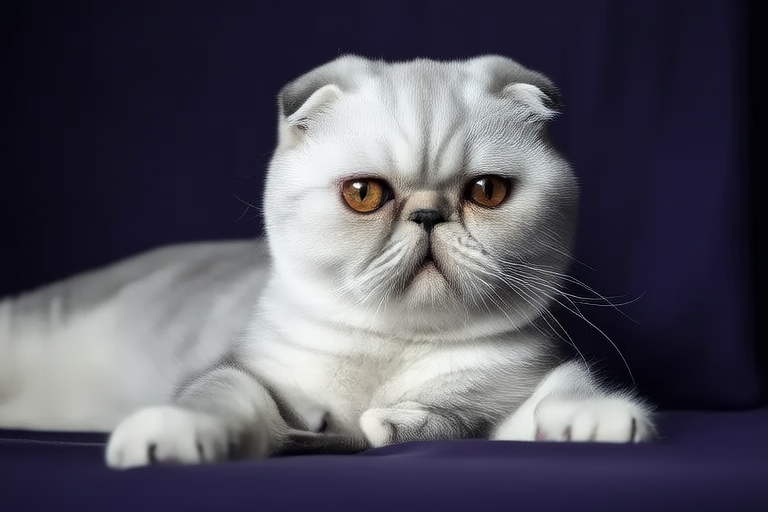Scottish Fold Cats: A Comprehensive Guide
The Scottish Fold is a breed of cat known for its distinctively folded ears. This unique characteristic has made them one of the most recognizable and sought-after breeds in the world. However, there’s much more to these felines than just their folded ears. From their gentle, friendly nature to their specific health concerns, Scottish Folds have a rich history and an array of traits that make them beloved pets.
A Brief History of the Scottish Fold
The story of the Scottish Fold begins in 1961 when a barn cat named Susie, with a natural mutation causing her ears to fold forward, was found near Coupar Angus, Scotland. William Ross, a neighboring farmer and cat fancier, took interest in Susie’s kittens, noticing that some inherited her unique ear structure. He began breeding these cats, initially crossing them with British Shorthairs to preserve the desirable traits while maintaining a sturdy body type.
In 1971, the breed was introduced to America by Nancy Abeille, who imported a pair of Folds. The breed quickly gained popularity in both countries due to their charming appearance and affectionate nature. Despite their initial success, the breed faced setbacks when the Governing Council of the Cat Fancy (GCCF) in the UK banned them from shows in 1978, citing potential health issues associated with the dominant gene responsible for the folded ears. Today, however, the breed remains popular in North America and enjoys recognition from various cat registries worldwide.
Distinguishing Features Beyond Folded Ears
While the folded ears are undoubtedly the most noticeable feature of the Scottish Fold, there are several other characteristics that set them apart from other breeds:
- Gentle Disposition: Scottish Folds are known for their calm, docile temperament. They enjoy being around people and often seek out human companionship, making them excellent lap cats.
- Adaptable Nature: These cats adapt well to different living situations, whether it be a bustling household or a quieter environment. Their adaptability makes them suitable for families with children or other pets.
- Social Behavior: Scottish Folds tend to be very social animals, often forming strong bonds with their owners. They may follow you around the house, wanting to participate in your daily activities.
- Distinctive Face: In addition to their folded ears, Scottish Folds have round faces with large, expressive eyes. Their facial structure gives them an endearing, almost owl-like appearance.
Care Requirements
Scottish Folds require regular grooming to maintain their luxurious coats. Their fur can range from short and dense to medium-length and requires brushing at least once a week to prevent matting and remove loose hair. Regular nail trimming, dental care, and ear cleaning are also important aspects of their grooming routine.
Feeding Scottish Folds a balanced diet is crucial for their overall health. High-quality cat food that meets their nutritional needs should be provided, taking into account their age, weight, and activity level. Obesity is a common issue among indoor cats, so portion control and regular exercise are essential to keep your Fold healthy.
Exercise is vital for maintaining the physical and mental well-being of Scottish Folds. Interactive toys, scratching posts, and playtime with their owners help stimulate their minds and bodies. Providing opportunities for climbing, jumping, and exploring will keep them active and engaged.
Health Considerations
Despite their many positive attributes, Scottish Folds face certain health challenges due to their genetic makeup. The dominant gene responsible for the folded ears can lead to osteochondrodysplasia, a condition affecting bone development. This can cause painful joint problems, particularly in the tail, legs, and spine. Early signs of discomfort may include difficulty walking, reluctance to jump, or lameness.
To minimize the risk of these health issues, reputable breeders perform selective breeding practices. They avoid breeding two folded-eared cats together, instead opting to crossbreed with straight-eared cats to reduce the incidence of osteochondrodysplasia. Genetic testing is also employed to identify carriers of the gene and ensure only healthy cats enter breeding programs.
Stories Highlighting Their Unique Charm
One heartwarming story involves a Scottish Fold named Oreo, who became an internet sensation after his owner posted videos of him playing fetch. Oreo’s playful antics showcased the breed’s intelligence and willingness to engage in interactive games. His videos captured the attention of millions, demonstrating how Scottish Folds can be both affectionate companions and fun-loving pets.
Another tale features a Scottish Fold named Luna, who adopted a family of ducks. After discovering the ducks in her backyard, Luna befriended them, following them around and even sharing her food. Her gentle nature and protective instincts towards the ducks exemplify the breed’s nurturing personality.
Conclusion
Scottish Folds are more than just cats with folded ears; they are loving, adaptable companions with a rich history and unique charm. Their gentle disposition, social behavior, and distinctive appearance make them ideal pets for many households. While they do come with specific care requirements and potential health concerns, the joy and companionship they provide make them cherished members of families around the world.
